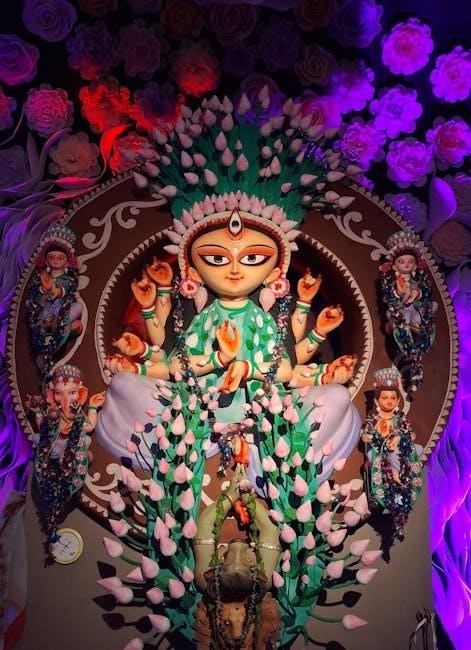E․M․ Forster’s A Passage to India, published in 1924, is a classic novel exploring cultural misunderstandings and tensions in colonial India․ Available as a PDF, it remains a vital read for understanding historical and modern cultural divides․
1․1․ Background and Publication of “A Passage to India”
E․M․ Forster’s A Passage to India was published in 1924, set during the British Raj, and explores cultural misunderstandings and racial tensions in colonial India․ The novel reflects the complexities of East-West relations, delving into themes of imperialism and identity․ Forster’s masterpiece is now in the public domain in the United States, making it widely accessible; Readers can easily find the novel in formats like PDF, ePub, and Mobi, with many platforms offering free downloads․ Its historical significance and enduring relevance ensure it remains a vital read for understanding colonial dynamics and cross-cultural interactions․ The novel’s exploration of human connections and societal divides continues to resonate with modern audiences, making it a cornerstone of colonial literature․
1․2․ Historical Context of Colonial India
The novel A Passage to India is set during the British Raj, a period of colonial rule in India that lasted from 1858 to 1947․ This era was marked by deep racial and cultural divides, with the British occupying a position of power while Indians struggled for independence․ The novel captures the tensions of this time, particularly the growing resistance to British rule and the complexities of cross-cultural interactions․ Forster’s portrayal of colonial India reflects the social and political upheavals of the early 20th century, including the rise of the Indian independence movement and the Non-Cooperation Movement led by figures like Mahatma Gandhi․ The historical context also highlights the rigid social hierarchies and the exploitation inherent in colonialism, which are central to the novel’s themes․ The availability of the novel in formats like PDF has made it accessible to modern readers, preserving its historical significance․
1․3․ Importance of the Novel in Modern Literature
A Passage to India remains a cornerstone of modern literature, offering profound insights into cultural tensions and identity․ Its exploration of colonialism, race, and cross-cultural misunderstandings resonates today, making it a vital text for understanding historical and contemporary social dynamics․ The novel’s nuanced portrayal of human relationships and societal conflicts continues to influence writers and scholars, ensuring its relevance in academic and literary circles․ Moreover, its availability in formats like PDF has made it accessible to a global audience, preserving its legacy for future generations․ Forster’s masterpiece not only reflects the past but also challenges readers to reflect on ongoing issues of cultural divides and prejudice, solidifying its importance in modern literary discourse․
Themes and Symbolism in “A Passage to India”
A Passage to India explores cultural clashes, colonial tensions, and identity through rich symbolism․ The Marabar Caves represent emptiness and confusion, while the novel’s themes of isolation and misunderstanding remain timeless critiques of colonialism․
2․1․ Cultural Misunderstandings and Prejudices
A Passage to India delves deeply into the cultural misunderstandings and prejudices prevalent during the British colonial rule in India․ The novel highlights the deep-seated mistrust and stereotypes between the British and Indians, as well as the emotional and social barriers they create․ Forster portrays how colonialism fosters mutual suspicion, with the British often viewing Indians as inferior and Indians resenting the British for their arrogance․ The character of Dr․ Aziz, a well-educated Indian, faces constant suspicion from the British, while characters like Adela Quested struggle to reconcile their preconceived notions of India with its complex reality․ These misunderstandings culminate in the infamous incident at the Marabar Caves, which serves as a symbol of the irreparable rift between the two cultures․ Forster’s exploration of these themes remains a powerful critique of colonialism and its enduring impact on human relationships․
2․2․ The Struggle for Identity in Colonial India
In A Passage to India, the struggle for identity is a central theme, particularly for Indians living under British colonial rule․ The novel portrays how colonialism disrupted traditional identities and created a sense of dislocation․ Indian characters like Dr․ Aziz and Mr․ Hamidullah grapple with their cultural heritage while navigating the imposing presence of British authority; The British, too, face identity crises, as their superiority is constantly challenged by India’s complexity․ Forster highlights the tension between embracing Western modernity and preserving traditional values․ Characters such as Cyril Fielding and Adela Quested embody this conflict, questioning their roles as British citizens in a colonized land․ The novel underscores how colonialism fosters a fragmented sense of self, leaving both colonizers and colonized searching for a coherent identity․ This struggle remains a poignant reflection of the psychological toll of imperialism and its lasting impact on individual and collective identity․
2․3․ The Role of Friendship Across Cultural Divides
In A Passage to India, friendship serves as a bridge between cultures, offering hope for understanding in a deeply divided society․ The relationship between Dr․ Aziz and Cyril Fielding exemplifies this theme, as they navigate their differences with mutual respect and empathy․ Fielding, a British educator, represents a more open-minded perspective, while Aziz embodies the complexities of Indian identity under colonial rule․ Their bond is tested by the Marabar Caves incident, which strains their trust and highlights the fragility of cross-cultural connections․ Despite these challenges, their friendship ultimately endures, symbolizing the possibility of unity in a fractured world․ Forster also explores how friendships like theirs challenge stereotypes and foster dialogue, offering a counterpoint to the pervasive mistrust and prejudice of colonial society․ Through these relationships, the novel underscores the transformative power of friendship in transcending cultural and racial barriers, even in the face of systemic oppression․
2․4․ Spirituality and the Search for Meaning
Spirituality and the quest for deeper meaning are central themes in A Passage to India, reflecting the novel’s exploration of human connection and existential inquiry․ Mrs․ Moore, a central character, embodies this theme through her spiritual journey, seeking transcendence beyond the material world․ Her experiences in India, particularly her encounter with the Marabar Caves, symbolize the search for the divine and the universal․ The caves, with their echoing “mystic vapour,” represent the ineffable and the mysterious, challenging characters to confront the limits of human understanding․ Forster critiques the rigid structures of organized religion, instead emphasizing a more personal and introspective spirituality․ The novel also explores the tension between Western rationality and Eastern mysticism, highlighting the ways in which spirituality can bridge cultural divides․ Ultimately, the search for meaning in A Passage to India is a metaphor for the human condition, urging readers to embrace the unknown and seek connection on a deeper plane․

2․5․ Symbolism of the Marabar Caves
The Marabar Caves in A Passage to India are a profound symbolic element, representing the void, the unknown, and the dissolution of human constructs; The caves, with their eerie echoes and dark, formless interiors, symbolize the cosmic emptiness that lies at the heart of existence․ They challenge the characters’ perceptions of reality, faith, and identity․ For Adela Quested, the caves become a space of disillusionment, where her assumptions about India and herself are shattered․ The incident in the caves also underscores the impossibility of human connection in a colonial context, as misunderstandings and accusations arise from the void of cultural comprehension․ The caves further symbolize the futility of human attempts to impose meaning on the unknowable, reflecting Forster’s critique of imperialism and organized religion․ Ultimately, the Marabar Caves serve as a metaphor for the insurmountable divide between East and West, and the search for meaning in a chaotic world․
Characters and Character Development
The novel explores complex characters like Dr․ Aziz, Adela Quested, Cyril Fielding, and Mrs․ Moore, each embodying distinct cultural and emotional journeys that reflect the tensions of colonial India․
3․1․ Dr․ Aziz: A Symbol of Colonial Tensions
Dr․ Aziz, a young Indian physician, embodies the complexities of colonial tensions in British India․ His character represents the indigenous perspective, marked by pride in Indian culture and resentment toward British dominance․ Aziz’s interactions with British characters like Adela Quested and Mrs․ Moore reveal his attempts to bridge cultural divides, yet they are often met with misunderstanding․ His strained relationships highlight the power dynamics of colonialism, where even well-intentioned individuals face systemic mistrust; The Marabar Caves incident further complicates Aziz’s life, casting him as a victim of colonial prejudice․ Despite this, Aziz’s journey reflects resilience and a growing sense of self-awareness, as he navigates the challenges of maintaining his identity in a oppressive environment․ His friendship with Cyril Fielding offers a rare glimpse of genuine connection across cultural lines, underscoring the novel’s exploration of human relationships amidst political turmoil․
3․2․ Adela Quested: The Dilemma of a British Woman in India
Adela Quested, a British woman traveling to India to consider marrying Ronny Heaslop, embodies the complexities faced by British women in colonial India․ Her curiosity about the “real” India and desire for personal independence set her apart from the conventional British community․ Adela’s interactions with Dr․ Aziz highlight the misunderstandings and prejudices prevalent between the British and Indians, showcasing her open-mindedness yet ultimately leading to significant personal and legal consequences․ The incident in the Marabar Caves serves as a pivotal moment, underscoring the societal expectations and internal conflicts she faces; Through her journey, Forster explores the tensions between British identity and the allure of Indian culture, illustrating how colonialism impacts individual lives and relationships․ Adela’s story reflects the broader colonial dynamics, offering insight into the challenges faced by women in a rigid, oppressive environment․
3․3․ Cyril Fielding: The Liberal Mind in Conflict
Cyril Fielding, the principal of Government College in Chandrapore, represents a liberal and open-minded perspective in the rigidly divided society of colonial India․ His friendships with both Dr․ Aziz and Adela Quested highlight his attempt to bridge the cultural gap between the British and Indians․ Fielding’s character embodies the tension between intellectual ideals and the practical realities of colonial life․ While he advocates for equality and understanding, he struggles with the limitations imposed by his British identity and the societal expectations surrounding him․ His relationship with Adela, particularly after the Marabar Caves incident, further complicates his stance, as he finds himself caught between his loyalty to her and his empathy for Aziz․ Fielding’s journey reflects the internal conflict of a liberal mind striving to navigate the complexities of colonialism, ultimately revealing both the possibilities and constraints of cross-cultural connections in such a fraught environment․
3․4․ Mrs․ Moore: The Spiritual Seeker
Mrs․ Moore, a British woman visiting India with her son, embodies a deep sense of spirituality and empathy․ Her character serves as a bridge between the spiritual and the mundane, reflecting her search for meaning beyond the material world․ Unlike other British characters, Mrs․ Moore approaches India with an open heart, seeking to understand its culture and people․ Her friendship with Dr․ Aziz highlights her ability to transcend racial and cultural barriers, showcasing her liberal and inclusive nature․ The Marabar Caves incident profoundly affects her, leading to a philosophical introspection about life’s mysteries and the human condition․ Mrs․ Moore’s character symbolizes the universal quest for spiritual enlightenment and her eventual disillusionment underscores the complexities of human connection in a colonial setting․ Through her journey, Forster explores themes of spirituality, tolerance, and the enduring search for truth, making her one of the novel’s most compelling and thought-provoking figures․
3․5․ The Development of Relationships
The development of relationships in A Passage to India is central to the novel’s exploration of cultural divides and human connection․ Initially, friendships like that between Dr․ Aziz and Mrs․ Moore bridge the gap between British and Indian cultures, fostering mutual understanding․ However, the Marabar Caves incident disrupts these relationships, leading to mistrust and misunderstanding․ Adela Quested’s strained interactions with both Dr․ Aziz and Cyril Fielding highlight the tension between individual emotions and societal expectations․ Meanwhile, the friendship between Fielding and Aziz, though flawed, represents a rare attempt at cross-cultural unity․ The novel demonstrates how relationships are shaped by colonial dynamics, often resulting in emotional distance and unresolved conflicts․ Despite these challenges, the characters’ connections reveal the resilience of human bonds in the face of adversity․ Through these evolving relationships, Forster critiques the social barriers of colonial India while offering a nuanced portrayal of human frailty and the quest for connection․

Literary Significance and Critical Reception
A Passage to India is a landmark novel in colonial literature, praised for its nuanced exploration of cultural tensions and social dynamics․ Critics acclaim its profound themes and complex characters, while debates about its portrayal of race and gender persist, cementing its status as a timeless classic in modern literary discourse․

4․1․ E․M․ Forster’s Writing Style
E․M․ Forster’s writing style in A Passage to India is distinguished by its lyrical prose, nuanced character development, and philosophical depth․ Forster employs a detached narrative voice, blending irony and symbolism to explore complex cultural and moral themes․ His prose is both precise and evocative, capturing the atmospheric richness of colonial India while delving into the inner lives of his characters․ The novel’s structure, divided into three parts, reflects Forster’s non-linear storytelling approach, which mirrors the fragmented nature of human relationships and societal tensions․ His use of dialogue is equally masterful, revealing the subtleties of class, race, and gender dynamics․ Forster’s ability to balance intellectual inquiry with emotional resonance has made his writing enduringly influential, resonating with readers long after the novel’s publication․
4․2․ Critical Analysis of the Novel
Critical analysis of A Passage to India underscores its profound exploration of colonialism, cultural divides, and human relationships․ Scholars praise Forster’s nuanced portrayal of the complexities of imperialism, particularly through the lens of personal interactions․ The novel is celebrated for its layered characters, such as Dr․ Aziz and Adela Quested, whose experiences highlight the tensions between colonizers and the colonized․ Critics often note the novel’s ambiguous ending, which reflects the broader uncertainties of cross-cultural understanding․ Some argue that Forster’s depiction of Indian characters occasionally lacks depth, reinforcing stereotypes․ Nevertheless, the novel remains a cornerstone of colonial literature, offering a searing critique of British imperialism․ Its exploration of spirituality and the clash of Eastern and Western values further enriches its thematic depth․ Overall, A Passage to India is regarded as a masterful work that challenges readers to confront the complexities of power, identity, and connection․
4․3․ The Novel’s Impact on Colonial Literature
A Passage to India has profoundly influenced colonial literature by offering a nuanced critique of British imperialism and its impact on Indian society․ Published in 1924, the novel challenged prevailing colonial narratives by humanizing Indian characters and exposing the complexities of cultural interactions․ Its exploration of themes like cultural misunderstandings, power imbalances, and personal relationships across colonial divides set a new standard for literary portrayals of colonialism․ The novel’s success encouraged other writers to critically examine colonialism, fostering a more empathetic understanding of colonized peoples․ Additionally, its depiction of spirituality and the clash of Eastern and Western values enriched the discourse on cultural diversity․ While some critics argue its limitations, the novel remains a landmark in colonial literature, inspiring future authors to explore similar themes with depth and sensitivity․ Its legacy endures as a powerful critique of colonialism and a celebration of cultural complexity․

Relevance in Modern Times
A Passage to India remains relevant today for its exploration of racial tensions, cultural misunderstandings, and colonialism’s legacy․ Its themes resonate with modern discussions on identity, power, and cultural divides, offering timeless insights into human conflict and understanding․
5․1․ Racial and Cultural Tensions Today
The themes of racial and cultural tensions in A Passage to India remain strikingly relevant in modern times․ The novel’s exploration of colonial dynamics and societal divides continues to resonate with contemporary issues of discrimination, prejudice, and cultural misunderstandings․ In today’s globalized world, where diversity and inclusion are central to public discourse, Forster’s work offers a powerful lens through which to examine the lingering effects of colonialism and systemic racism․
The novel’s portrayal of power imbalances and cultural clashes mirrors modern struggles for equality and justice․ For instance, the tension between the British and Indian characters in the novel parallels current debates about race, identity, and privilege․ By examining these themes, A Passage to India encourages readers to reflect on how historical injustices shape contemporary societal norms and interactions․
Ultimately, the novel serves as a reminder of the enduring need for empathy, understanding, and dialogue in bridging cultural and racial divides․
5․2․ Comparisons with Other Works on Colonialism
A Passage to India is often compared to other seminal works that explore colonialism, such as Joseph Conrad’s Heart of Darkness and Chinua Achebe’s Things Fall Apart․ While Conrad’s novel delves into the psychological and moral decay of colonial powers, Forster’s work focuses more on the social and cultural tensions between colonizers and the colonized․ Similarly, Achebe’s novel presents a direct critique of colonialism from the perspective of the oppressed, whereas Forster’s approach is more nuanced, emphasizing the complexities of human relationships across cultural divides․
Forster’s portrayal of colonial India stands out for its subtlety and depth, avoiding simplistic portrayals of good versus evil․ Instead, he highlights the misunderstandings and mutual distrust that arise from deeply ingrained cultural and racial prejudices․ This approach makes A Passage to India a unique and thought-provoking contribution to the literature of colonialism, offering insights that remain relevant today․
5․3․ The Novel’s Influence on Contemporary Writers
A Passage to India has left an indelible mark on contemporary literature, inspiring writers to explore themes of colonialism, cultural identity, and social justice․ Authors like Salman Rushdie and Anita Desai have drawn inspiration from Forster’s nuanced portrayal of India under British rule․ Rushdie’s Midnight’s Children, for instance, reflects a similar exploration of cultural hybridity and the complexities of colonial legacy․

The novel’s emphasis on the inner lives of its characters and its exploration of moral ambiguity has influenced writers like Zadie Smith and Jhumpa Lahiri․ Forster’s ability to weave together personal narratives with broader societal themes has encouraged contemporary writers to tackle issues like race, identity, and power dynamics in their own works․ Furthermore, the novel’s blending of Eastern and Western storytelling traditions has inspired a generation of writers to experiment with diverse narrative styles․
The enduring relevance of A Passage to India ensures its continued influence on writers grappling with the complexities of globalization and cultural exchange․

Availability and Access to “A Passage to India PDF”
The novel is widely available in various formats, including PDF, eBook, and paperback․ Readers can access it through online platforms like Amazon, Google Books, or libraries, ensuring its enduring popularity․
6․1․ Downloading the PDF: Sources and Formats

“A Passage to India” in PDF format is readily accessible through various online platforms․ Popular sources include Amazon Kindle, Google Books, and Project Gutenberg, which offer the novel for download․ Many libraries also provide free access to digital versions through services like OverDrive or Scribd․ Additionally, several websites specialize in eBook downloads, offering “A Passage to India” in formats like PDF, ePUB, and MOBI․ These formats cater to different reading preferences, with PDF preserving the original layout, ideal for academic use, while ePUB and MOBI adapt to various screen sizes․ Some platforms may require purchase or subscription, but free versions are often available, especially for classic works․ Be sure to check the legality of downloads to ensure compliance with copyright laws․ This accessibility makes the novel easily attainable for readers worldwide, maintaining its relevance in modern literature․

6․2․ Reading the Novel Online
Reading “A Passage to India” online is a convenient option for those who prefer digital access․ Platforms like Project Gutenberg, Google Books, and Scribd offer the novel for free or through subscription services․ Many libraries also provide digital access, allowing users to borrow and read the book online via services like OverDrive or Libby․ Websites such as ManyBooks and HathiTrust Digital Library often include classic works in their catalogues, making it easy to access “A Passage to India” without downloading․ Additionally, online bookstores like Amazon Kindle and Barnes & Noble Nook offer the novel for immediate reading through their apps or websites․ This method eliminates the need for physical storage and allows readers to access the text from multiple devices․ The availability of online versions ensures that readers can engage with Forster’s timeless work without the hassle of downloading or purchasing a physical copy․
6․3․ Legal and Copyright Considerations
“A Passage to India” by E․M․ Forster is in the public domain in many countries, as the novel was published in 1924 and copyright typically expires 70 years after the author’s death․ Forster passed away in 1970, so the book is now freely available in most regions․ However, specific editions or annotated versions may still be under copyright due to additional content like introductions or commentary․ Users should verify the copyright status of the edition they are accessing to ensure compliance with local laws․ In some countries, copyright extensions or regional laws may apply, so it is essential to check legal guidelines before downloading or sharing the PDF․ Respect for intellectual property and adherence to copyright rules are crucial, even for classic works like “A Passage to India․”
